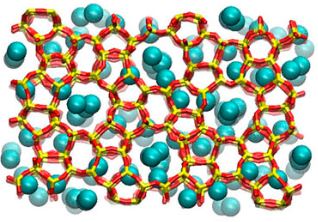On De Gennes narrowing of fluids confined at the molecular scale in nanoporous materials
Wanda Kellouai, Jean-Louis Barrat, Patrick Judeinstein, Marie Plazanet, Benoit Coasne, J. Chem. Phys. 160, 024113 (2024).
Beyond well-documented confinement and surface effects arising from the large internal surface and severely confining porosity of nanoporous hosts, the transport of nanoconfined fluids remains puzzling in many aspects. With striking examples such as memory, i.e., non-viscous effects, intermittent dynamics, and surface barriers, the dynamics of fluids in nanoconfinement challenge classical formalisms (e.g., random walk, viscous/advective transport)—especially for molecular pore sizes. In this context, while molecular frameworks such as intermittent Brownian motion, free volume theory, and surface diffusion are available to describe the self-diffusion of a molecularly confined fluid, a microscopic theory for collective diffusion (i.e., permeability), which characterizes the flow induced by a thermodynamic gradient, is lacking. Here, to fill this knowledge gap, we invoke the concept of “De Gennes narrowing,” which relates the wavevector-dependent collective diffusivity D0(q) to the fluid structure factor S(q). First, using molecular simulation for a simple yet representative fluid confined in a prototypical solid (zeolite), we unravel an essential coupling between the wavevector-dependent collective diffusivity and the structural ordering imposed on the fluid by the crystalline nanoporous host. Second, despite this complex interplay with marked Bragg peaks in the fluid structure, the fluid collective dynamics is shown to be accurately described through De Gennes narrowing. Moreover, in contrast to the bulk fluid, the departure from De Gennes narrowing for the confined fluid in the macroscopic limit remains small as the fluid/solid interactions in severe confinement screen collective effects and, hence, weaken the wavevector dependence of collective transport.





